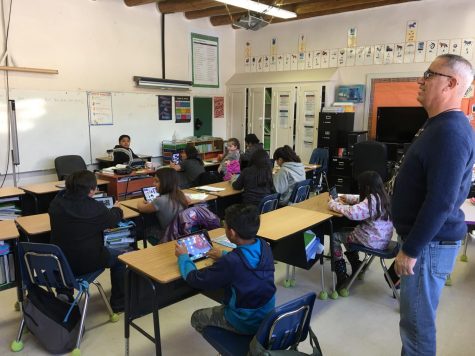Columbia forms civic media partnership with New Mexico elementary school
June 25, 2019

Columbia donated 14 iPads to an elementary school in New Mexico located on the Taos Pueblo Indian Reservation for students to learn civic media skills with the technology.
Students at a New Mexico elementary school are now using iPads donated by Columbia for a number of projects, ranging from recording the oral history of their Native American elders to creating music videos.
The college donated 14 iPads to Taos Day School in accordance with its partnership with True Kids 1, a media education nonprofit that helps New Mexico youth cultivate digital skills.
The partnership was created in May 2018 by Yonty Friesem, an assistant professor in the Communication Department and the director of graduate studies for the new Civic Media program. True Kids 1 asked Friesem for his assistance with a new civic media curriculum Taos Day School was introducing to their school and community.
“We’re focusing on empowering the students,” Friesem said.
In August 2018, the nonprofit connected Friesem with the school, located on the Taos Pueblo Indian Reservation. Friesem facilitated a workshop with Taos Day teachers, in which he assisted them with technical tools to produce various civic media projects, such as a suicide prevention video, which was featured at a local showcase May 16.
The donated iPads will be used to help make students more comfortable with the multifaceted process of interviewing and to increase their language acquisition. The iPads also allow students to be mobile, go off-campus and into the community.
“They can go home, interview their parents, interview the elders [and] interview tribal government members,” Taos Day School Principal Andrew Haimowitz said.
Given that Taos Day is on a reservation, there are government hoops to jump through to secure funding for such projects.
“Everything that [Taos Day] is doing needs to [be] approved by [the Bureau of Indian Education] so there’s no discrimination and that they are receiving the services they need,” Friesem said. “However, by doing that it actually creates more bureaucracy.”
Haimowitz suggested donations might be an avenue for them to get the necessary equipment for students sooner, according to Friesem.
Friesem contacted Kathie Koch, Columbia’s associate vice president and chief information officer of the Information Technology Department, in February, and she coordinated the donation, which was given to the school in early May.
Friesem said with the ability to have various apps on these devices, the technology will “enhance the students’ use of media production and public speaking, so that it will be related to civic media projects.”
The New Mexico school’s push toward technology-friendly education is seeping into other media disciplines as well. The students have high aspirations for what this introduction of technology will mean for them and their endeavors. Some students want to record the oral history of the elders of Taos as a memento for future generations. One student wants to start a grunge band; some want to make music videos.
“The idea is that in 10 years, 20 years, 50 years, there is going to be an archive in the school … that will have that information,” Friesem said. “What we’re doing is … teaching the technical skills and how to use it properly, and then they choose what they want to do with it.”
The program will focus on upper-level students first so they can pass the knowledge on to younger students.
Friesem said the new Civic Media graduate program that begins in Fall 2019 at Columbia will help broaden the partnership.
“The students in the [Civic Media] program will be taking some part in the evaluation … to take part and to think about how we can do this kind of collaboration,” he said. “What we are going to start to explore is … how different initiatives that we are doing in the department and in our classes can work with things that would help the pueblo.”
Haimowitz has ideas about the future of the partnership as well. He looks forward to learning more about Columbia and building upon the partnership.
“We need the college to be somewhat omnipresent, whether it’s over the phone calling us and checking up on us, coming here … letting people know who Columbia College is,” Haimowitz said.
An important takeaway from this partnership is the focus on updated and modern education that will benefit students in ways previous curriculum could not.
“Columbia made a very generous step toward this partnership,” Friesem said. “I think it needs to be seen as a first step in a partnership to really continue the commitment of Columbia to civic media and civic engagement that is beyond the class walls.”







